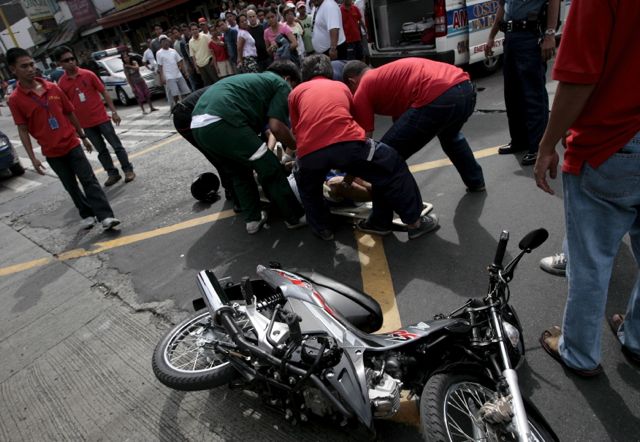
Chris Dalisay Luis last rode his bicycle on September 23, 2015. He used to bike to work everyday from Parañaque to Pasay to beat the terrible traffic.
September 23, though, was a special day for Chris. It was supposed to have been his last day at work. The call center manager was reportedly retiring.
But Chris never made it to the despedida prepared by his coworkers. At around 7 am, someone driving an SUV crashed into him while he was biking along Magsaysay Boulevard. Chris reportedly suffered severe head injuries, and he died on the spot.
Chris was 38 years old. At a time when he and his family should have been celebrating his retirement, his life was cut short in a road crash. He left behind a wife and a 5-year-old son.
Shattered lives
In a matter of seconds, a road crash can dramatically change lives.
When the crash results in death, shattered families must cope with the pain of losing a family member. And, if the road crash victim is a breadwinner, the family must also tighten its belt. Dreams of getting an education or investing in a home may be put on hold.
If the crash results in injuries, family members must pay for the costs of prolonged medical care. They also need to take time off from work or from school to care for the injured.
Road crashes are a devastating events. Every hour, one person dies on our nation’s roads. Every day, 28 people don’t make it home alive to have dinner with their families. In a year, that adds up to 10,379 people – or about 188 busloads of people. (READ: Road deaths in PH: Most are motorcycle riders, pedestrians)
Shared suffering
Sadly, road crashes have become “routine” events. Many of us have grown immune to the almost daily headlines about a serious road crash somewhere in our country. We may, at first, beat our breasts or sigh out of despair; but, in time, the names of the injured or the dead may fade from our memory.
Let’s not allow that to happen. On Sunday, November 15, let us pause to remember Chris Luis and all those who are killed and seriously injured on the world’s roads. It’s not just another Sunday. That date marks World Day of Remembrance for Road Traffic Victims.
Why do we need to remember road crash victims? “Public reflection is the act of recognition. It states to the victims and their families that their humanity is valued, that their loss is our loss and that their suffering is shared, if only through recognising the tragedy and error of its occurrence.” (The preceding, an excerpt from the Holocaust Memorial Day Booklet 2007, is quoted in World Day of Remembrance for Road Traffic Victims: a guide for organizers.)
Here are some ways we can honor the memory of all road victims:
Pledge to say “road crash” and not “accident.” The two words are often used to describe the same event, but in reality each word conjures up a very different image.
A road crash results from “choices made and risks disregarded.” On the other hand, an accident is something that cannot be reasonably foreseen and cannot be avoided.”
Observe a minute of silence before we set out on the day’s journey. Whichever our preferred mode of transport, let’s all be responsible road users.
Those who are driving motor vehicles, please drive sober, observe the speed limits, and respect pedestrian crossings and sidewalks. The people who are on motorcycles and bicycles, please wear helmets. Pedal pushers should also be visible by wearing light-colored clothes or blinking lights. Those who are walking would do well to use blinkers, too.
Watch and share a road safety video. Luc Besson’s 3-minute film, “Save Kids’ Lives,” is riveting.
Read the Child Declaration for Road Safety. Then sign it, and share it with friends.
Finally, let’s pressure our government to take the proven measures highlighted in the World Health Organization Global status report on road safety 2015:
- Improve laws and enforcement on risks such as speeding, drinking and driving, and failing to use seat-belts, motorcycle helmets and child restraints;
- Update roads with protective infrastructure such as sidewalks and dedicated lanes for pedestrians and cyclists;
- Ensure that vehicles everywhere are equipped with life-saving technologies including seat-belts and air bags; and
- Enhance emergency trauma care systems for victims.
– Rappler.com
Dinna Louise C. Dayao (dinnadayao@gmail.com) is an experienced writer and editor. She organized the Metro Manila Transit Riders’ Union and the Change.org petition calling on President Aquino to require all public officials to ride public transit at least once a month.